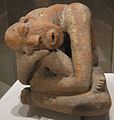Djenne-Djeno
| Old towns of Djenné | |
|---|---|
|
UNESCO world heritage |
|
| National territory: |
|
| Type: | Culture |
| Criteria : | iii, iv |
| Reference No .: | 116 |
| UNESCO region : | Africa |
| History of enrollment | |
| Enrollment: | 1988 (session 12) |
Djenne-Djeno ( old Djenne , also Jenne-Jeno or Zoboro ) is a hill of ruins about three kilometers southeast of Djenné in present-day Mali . It is the predecessor town of Djenné and one of the oldest urban centers south of the Sahara .
The local hill measures about 33 hectares and is up to eight meters high in places. Its arrangement is roughly teardrop-shaped. Because of its hill location, the place is protected from the annual floods. A supply channel of the river Bani is abandoned today.
Various excavations were carried out here between 1977 and 1981, with eleven segments of the city being excavated. C-14 radio dates indicated that the city began to exist around 250 BC. Until around 1400 was inhabited. The history of the city could be divided into four phases (I – IV) using ceramics. Around 100 AD it enclosed an area of over 25 hectares. In phase I – II (approx. 250 BC to 300 AD) people lived from fishing, from antelopes and domesticated cows. The residents seem to have lived in rather simple huts and adobe houses. But there was also a fine ceramic, decorated with incised patterns, millstones for grain and signs of iron smelting . Pearls were found that were probably traded here from the Mediterranean.
In phase III (from 300 to 800 AD) the city reached its greatest extent. A fine, partially painted ceramic comes from this time, as do iron finds, stone beads, copper and gold jewelry. The last of the materials must have been imported, which indicates extensive trade relations. It was possible to excavate some urn burials from this phase, from which, however, no significant social differentiations within the population can be read. In this phase, the adobe houses were built close to each other and had narrow streets. At that time the city was surrounded by a wall about 3.6 kilometers long. It is believed that several thousand people lived here. In phase IV, a slow decline can be observed until the city was moved to Djenné around 1400, probably with the arrival of Islam . There were numerous terracotta figures . Carved images of animals appear on the ceramic.
- Terracotta figures from Djenné
1988 Djeno, along with the old town of Djenne by the UNESCO on the list of World Heritage set. The hills ( Tougéré ) Kaniana , Tonomba and Hambarketolo , which are also located in the flood area of the Bani, are among the protected sites.
literature
- Susan Mcintosh (Ed.): Excavations at Jenne-Jeno, Hambarketolo, and Kaniana (Inland Niger Delta, Mali), the 1981 Season. University of California Press, Berkeley 1995.
- Susan Keech McIntosh, Roderick McIntosh: Cities without citadels: understanding urban origins along the middle Niger. In: T. Shaw, P. Sinclair, B. Andah, A. Okpoko (Eds.): The Archeology of Africa. London / New York 1993, pp. 622-641, ISBN 0-415-11585-X .
Web links
- Entry on the UNESCO World Heritage Center website ( English and French ).
- Susan Keech McIntosh and Roderick J. McIntosh: Jenne-jeno, an ancient African city. Rice University (English)
- Summary Description of the Pottery of the Jenne-jeno, Hambarketolo, and Kaniana Assemblages. Rice University (English)
- Excavations in Djenne-Djeno with pictures of some clay figures. Au coeur du mali web portal archived in October 2009 (French)
Individual evidence
- ↑ Pekka Masonen: Trans-Saharan Trade and the West African Discovery of the Mediterranean World ( Memento of May 28, 2013 in the Internet Archive ). Conference contribution. The third Nordic conference on Middle Eastern Studies: Ethnic encounter and culture change. Joensuu, Finland, 19-22. June 1995 (English).
Coordinates: 13 ° 53'24 " N , 4 ° 32'25" W.




